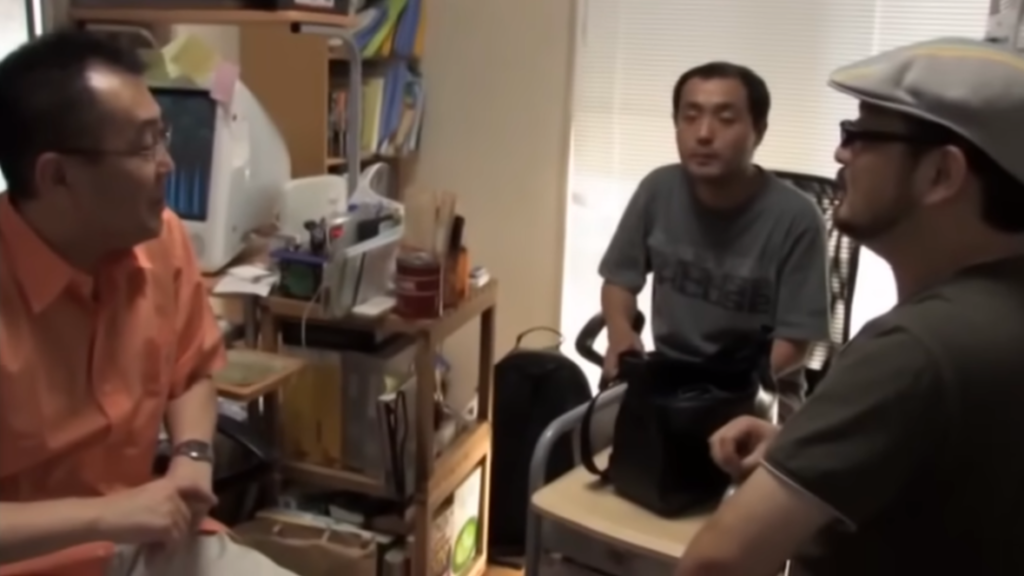Occult [Okaruto]
2009

Rated: NR
Genre: Horror, Mystery, Pseudo-Documentary
Country: Japan
Run-Time: 1h 50min
Director: Kōji Shiraishi
Cast
Uno Shohei………………………….Shohei Eno
Kōji Shiraishi…………………….….himself
Shinobu Kuribayashi………..herself
“What the hell was that?”
That’s the general reaction people have watching Kōji Shiraishi’s second attempt at a horror pseudo-documentary, the 2009 Occult [Okaruto].
Of course, Shiraishi knocked it out of the park with his first documentary-style horror, Noroi: The Curse. But his follow up, Occult, is not nearly as well known, especially in the West.
Not that Shiraishi wasn’t making movies in the meantime. In 2007 he directed Carved: The Slit Mouthed Woman. Hell, he even released the notorious extreme horror gorefest Grotesque only months before Occult. Needless to say, Shiraishi is a bit of a Japanese horror legend. But it’s his work on pseudo-documentaries with elements of cosmic horror, particularly Noroi, that have made the biggest impact inside the horror community.
In fact, Shiraishi’s four pseudo-documentaries– Noroi, Occult, Cult, and A Record of Sweet Murder- are kind of a franchise. They have recurring imagery and tell stories involving old Japanese Gods messing with people, causing many to speculate that these films are actually part of a shared universe.
So why have so few people in the West heard of Occult, especially since Noroi: The Curse is now a pretty well-known J-horror title? I’ll be honest, I don’t know- but I think I can make a few educated guesses.
For one thing, you have to appreciate that there was a time when Noroi was not so well known outside of Japan. It missed out on Hollywood’s J-horror remake craze, not that its X-Files-type mystery involving an old Japanese mythology would have ever been easy to adapt. Noroi: The Curse has only been discovered more recently after the constant badgering from horror fans insisting that it was a forgotten masterpiece. But in 2005, Noroi did not get a strong North American release, and Occult, which came four years after, got even less of one.
But I am also guessing Western distributors would have been turned off by the low budget effects- more on this later- and a plot about extremist terrorism that would had hit too close to real-world fears and at times views like a how-to video. Then there’s that Japanese God stuff again. No doubt Occult would have been seen as a much less accessible, more controversial film than Noroi, and since so few people in the West had seen Noroi, you didn’t have that marketing angle to work with.
But nearly two decades later, Noroi: The Curse has gained a significant cult following and I wouldn’t be surprised if Occult doesn’t start to get more recognition from the West too. In fact, I suspect this process is already happening. After all, we in the horror community are an intelligent group and know a thing or two about uncovering lost gems.
So strap yourself in and prepare for a tale about U.F.O.s and miracles. Random stabbings and suicide bombers. And even a few scenes involving shadowy creatures, leech faces, ghost photos, psychedelic hellscapes, Kiyoshi Kurosawa and Indiana Jones and the Kingdom of the Crystal Skull…cause why not?
Occult begins with the investigation of a mass stabbing that took place three years earlier at a resort in Myogasaki. A small documentary team involving director Kōji Shiraishi (playing himself) and assistant director Shinobu Kuribayashi (also playing herself) begin their film questioning the survivors of the incident, friends and family of the victims, as well as the murderer’s parents.
Through videos of onlookers at the time, we then watch the tragic incident involving a man named Matsuki who stabbed several people on a bridge before climbing a nearby cliff and jumping into the ocean. It is presumed that Matsuki drowned after his murders, but his body was never recovered.
From the interviews, the crew learns that many of the victims felt a strange compulsion to be in Myogasaki on that day. We also learn that Matsuki carved a symbol on the back of his last surviving victim, Shohei Eno, telling him “It is your turn” before running off.
Later, Shohei Eno admits in an interview he and his mother- who confirms the story- had seen a U.F.O shortly after the incident.
Obviously, Shohei Eno (Uno Shohei) becomes a person of extreme interest as it seems that whatever paranormal forces compelled Myogasaki to kill might have passed the baton to him, so the crew call him into their office to show him footage of easy to miss circular object caught flying in the sky within the footage the Myogasaki massacre.
The film then takes an even more interesting turn when Eno, who admits he holds no grudge against Myogasaki, makes a vague claim that his life has been blessed by a series of “miracles“ ever since his run in with Matsuki. What exactly these “miracles” are and whether or not Eno is indeed turning into the next mass murderer make up most of the film’s second act.
Even more than Noroi, Occult is dependent on interpersonal relationships and the interactions between its characters to push the plot forward. The characters are much better developed in this film, and out of necessity I would say the performances are better as well.
But it is Uno Shohei’s character who really steals the show. Shohei Eno turns out to be an unemployed drifter with more optimism than one would expect for a man in his situation. The more time the crew spends with him, the more they learn that this optimism is rooted in a kind of religious peace he has found within himself after the incident. He hears voices- always worrying- and is sure that he is now one of God’s chosen. And here comes the conundrum, especially for Shiraishi’s fictionalized self. The more Shiraishi follows Eno, the easier it is for him to get sucked into his infectious outlook. And this only gets reinforced when the “miracles” actually start appearing. Eno really does seem to have been touched by some type of higher power and acceptance of this divine presence has seemingly changed him for the better; but at the same time it also seems like this presence led Myogasaki to commit mass murder.
There is something very unsettling about budding terrorists going about their final days in a manner similar to Shohei Eno. And this is the real power Occult has as a film. Whether a religious fanatic or domestic terrorist, most of these real-life psychopaths actually believe there is a higher purpose to their actions. Shiraishi dares to put us into the head of a fanatic and this makes for uncomfortable, yet equally hypnotic, viewing.
That’s not to say Occult is a better film than Noroi. It is not. Noroi’s mystery has far fewer dangling threads. But in Occult, where Shiraishi really drops the ball in the effects department. The special effects in this film usually fall between too ambitious for the budget or not nearly ambitious enough. Saying more would unfortunately completely spoil a load of surprises, but let’s just say that the soundtrack does a lot of the heavy lifting for the film.
But oh my God! That soundtrack by Masaya Nakahara (aka Hair Stylistics) is just so, so good. Even if you’re not convinced by the paranormal scare factor of a certain scene, it is hard to deny that the ambient industrial score is awesome. And that only adds to Occult’s odd appeal. Even when its horror visuals aren’t entirely working, the audio is still top-notch. It’s actually quite charming how hard this film tries to unsettle you despite its dime store budget. And I really mean it when I say this film was made on peanuts. I even suspect Shiraishi shot most of his outdoor and mall scenes guerilla-style.
But the main reason Noroi is the stronger film is because Occult’s mistakes take you out of the immersive experience that a pseudo-documentary need to have to be believable. And truth be told, so does the unnecessary cameo involving Kiyoshi Kurosawa (who directed the Cure [Kyua] and Pulse [Kairo]) as well as the significant leap forward in time.
Then there’s the ending. Noroi’s ending is one of the best in modern horror cinema, but Occult’s ending feels more like the punchline to a joke. Contextually, this ending is absolutely necessary. But it also could have been done in a way that is less of an attack on the film’s previous realism. It is really only forgivable because its at the end of the film. But as awful as it is, there is again an odd, memorable charm about it too. This is a hard movie to stay angry at.
And that’s something I’ve noticed reading online responses to the film. Most people are willing to forgive the campy effects because so many other aspects of the film work so well. In fact, one of the few negatives I read about the film- still by someone who liked it, was that they felt it didn’t age well-a comment directly pointed at the film’s poor special effects. But really, in this day and age, creating a remaster that polishes up some effects and recuts the ending would be fairly inexpensive and not that time consuming.
However, I think if Occult found its way onto the right streaming service, it wouldn’t need to change a thing. About half the people who I read commenting on the film had only done so in the last few years and they all seem overwhelmingly positive about the film, warts and all. In fact, I’d argue that aging is exactly what this film needed to become more accessible to Western audiences, especially for those who loved Noroi.
Do yourself a favour and seek Occult out.
